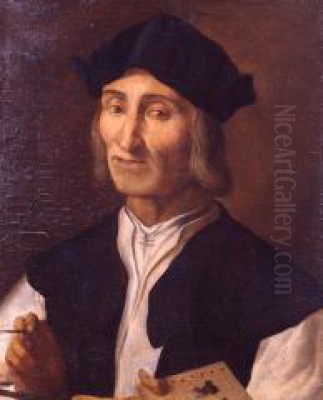
Marco Palmezzano stands as a significant, if sometimes overlooked, figure in the landscape of Italian Renaissance art. Active primarily in his native Forlì and the surrounding Romagna region, Palmezzano carved out a long and prolific career, leaving behind a substantial body of work characterized by its devotional sincerity, meticulous detail, and a distinctive, somewhat conservative style that nonetheless absorbed and reflected key artistic currents of his time. His life, spanning from approximately 1458 to 1539, witnessed profound transformations in Italian art, yet Palmezzano remained a remarkably consistent and dedicated painter, deeply rooted in the traditions of the Quattrocento even as the High Renaissance unfolded around him.
Early Life and Artistic Formation in Forlì
Marco Palmezzano was born in Forlì, a town in the Emilia-Romagna region of Italy, around 1458. While some sources suggest slightly earlier or later birth years (1456 or 1459), the consensus among art historians leans towards 1458. His death in Forlì in 1539 is more consistently documented. Forlì, during Palmezzano's formative years, was a vibrant cultural center, and it was here that he received his foundational artistic training.
The most significant influence on the young Palmezzano was undoubtedly Melozzo da Forlì (c. 1438–1494), one of the preeminent masters of perspective and monumental figurative painting in the latter half of the 15th century. Palmezzano is widely considered to have been Melozzo's pupil and assistant. Melozzo's own style was shaped by his contact with artists like Piero della Francesca, from whom he absorbed a profound understanding of geometric perspective and a sense for dignified, weighty figures. Melozzo's work in Rome, particularly his frescoes in the Basilica dei Santi Apostoli (fragments now in the Vatican Pinacoteca and Quirinal Palace), showcased his mastery of foreshortening and his ability to create illusionistic spaces. This training under Melozzo provided Palmezzano with a strong technical grounding, particularly in perspective and draughtsmanship.
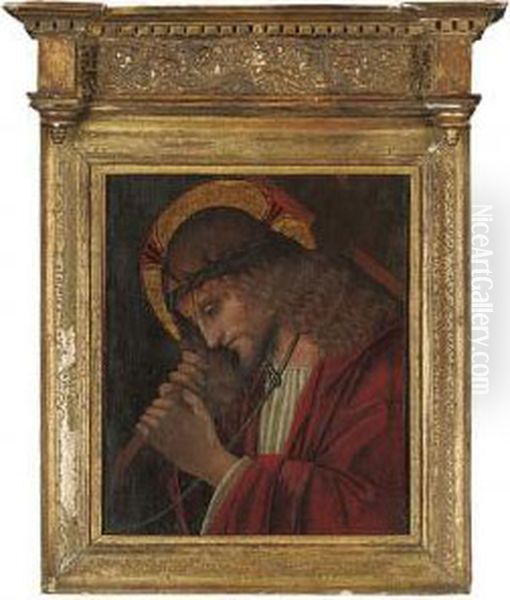
The artistic environment of Forlì and the wider Romagna region would also have exposed Palmezzano to influences from nearby artistic centers. The Ferrarese school, with artists like Cosmè Tura, Francesco del Cossa, and Ercole de' Roberti, was known for its expressive intensity and often sharp, linear style. Further afield, the Venetian school, particularly the work of Giovanni Bellini and his followers, was beginning to exert a powerful influence across northern and central Italy with its emphasis on color, light, and atmospheric effects. While Palmezzano's core style remained tied to Melozzo's teachings, these broader currents would subtly inform his development.
Artistic Style and Characteristics
Marco Palmezzano's artistic style is often described as conservative. Living through a period of immense artistic innovation that saw the rise of Leonardo da Vinci, Michelangelo, and Raphael, Palmezzano largely adhered to the stylistic conventions of the late Quattrocento. His work did not typically embrace the dynamic movement, complex contrapposto, or idealized humanism of the High Renaissance in the same way as his Florentine or Roman contemporaries. Instead, he cultivated a style characterized by clarity, precision, and a deep-seated piety.
A hallmark of Palmezzano's art is his meticulous attention to detail. This is evident in the rendering of fabrics, architectural elements, and landscape backgrounds. His figures, while sometimes appearing somewhat stiff or archaic compared to High Renaissance ideals, are rendered with care and precision. They often possess a quiet dignity and an earnest devotional quality. His compositions are generally well-ordered and balanced, often employing symmetrical arrangements that enhance their clarity and devotional focus.
Palmezzano's use of perspective, inherited from Melozzo, is a consistent feature of his work. He skillfully creates a sense of spatial depth in his paintings, often incorporating elaborate architectural settings or receding landscapes. However, his application of perspective can sometimes feel more formulaic or rigid than the more sophisticated and integrated spatial constructions of masters like Leonardo or Raphael. His color palette is typically clear and bright, with a preference for strong local colors, though he could also achieve subtle tonal gradations.
Thematically, Palmezzano's oeuvre is overwhelmingly religious. He produced numerous altarpieces, devotional panels, and narrative scenes for churches, confraternities, and private patrons throughout Forlì and the Romagna. This focus on sacred art reflects both the prevailing patronage of the era and Palmezzano's own apparent religious sensibilities. His works aimed to inspire devotion and contemplation, and they often convey a sense of serene piety.
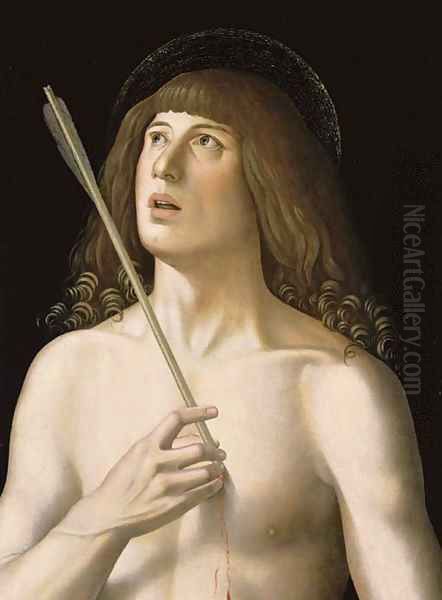
One interesting aspect of his career is his signature. He sometimes signed his works "Marcus de Melotius," which translates to "Marco of Melozzo." This has occasionally led to confusion, with some interpreting it as indicating he was Melozzo's son or a very close family member. However, it is more likely an acknowledgment of his discipleship and a way of associating himself with his renowned master, thereby enhancing his own artistic standing. Despite this, Palmezzano was an independent artist with his own distinct, albeit related, style.
Representative Works
Marco Palmezzano's prolific output includes many notable works that exemplify his style and thematic concerns. These paintings are primarily found in churches and museums in Forlì, the Romagna region, and various collections worldwide.
"Madonna and Child Enthroned with Saints": This is a recurring theme in Palmezzano's work, and he produced several variations. A fine example is the "Madonna and Child Enthroned with Saints John the Baptist and Jerome" (Pinacoteca Civica, Forlì). Such works typically feature a centrally enthroned Virgin and Child, flanked by saints, often set within an architectural niche or against a landscape backdrop. These paintings showcase Palmezzano's skill in composition, his clear color palette, and the dignified, if somewhat static, portrayal of his figures. The meticulous rendering of details, such as the saints' attributes or the folds of drapery, is characteristic.
"The Lamentation over the Dead Christ": Palmezzano treated this poignant theme on several occasions. One notable version is housed in the Pinacoteca di Brera, Milan. These compositions typically depict the Virgin Mary, Saint John the Evangelist, Mary Magdalene, and other followers mourning over the body of Christ. Palmezzano conveys the pathos of the scene through the expressive, albeit restrained, grief of the figures and the stark depiction of Christ's body. The clarity of the narrative and the emotional sincerity are key features.
"Christ Carrying the Cross": This subject, popular in the Renaissance, allowed artists to explore themes of suffering and redemption. Palmezzano's interpretations, such as the one in the Galleria Borghese, Rome, often focus on the physical and emotional burden of Christ. He is typically shown surrounded by soldiers and onlookers, with a landscape background. The influence of artists like Giovanni Bellini, who also produced powerful versions of this theme, can sometimes be discerned in the iconographic arrangements and emotional tenor.
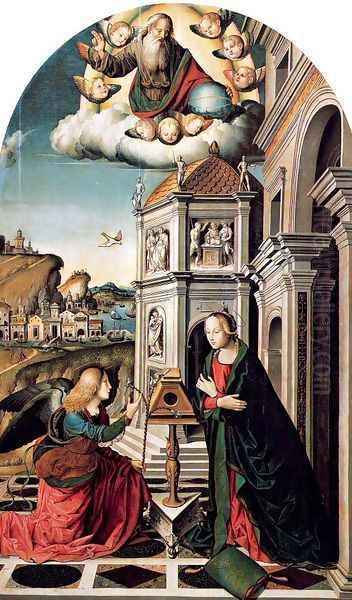
"Saint Sebastian": Palmezzano painted this popular saint multiple times, for instance, the panel dated 1525 in a private collection. Saint Sebastian, an early Christian martyr, was invoked against plague and was a favorite subject for Renaissance artists, allowing for the depiction of the idealized male nude. Palmezzano's versions typically show the saint bound to a tree or column, pierced by arrows. His rendering of anatomy is competent, though perhaps not as naturalistic or dynamic as that of some of his contemporaries. The landscapes in these works are often detailed and contribute to the overall composition.
"The Annunciation": Several Annunciation scenes by Palmezzano exist, for example, in the Pinacoteca Civica, Forlì. These works depict the Archangel Gabriel announcing to the Virgin Mary that she will conceive and bear the Son of God. Palmezzano typically sets the scene in an elegant interior or loggia, paying close attention to architectural details and symbolic elements. The figures of Gabriel and Mary are often portrayed with a gentle grace and piety.
"Baptism of Christ": An example of this theme is found in the National Gallery, London. Here, Palmezzano depicts Christ being baptized by John the Baptist in the River Jordan, with angels in attendance and the Holy Spirit descending as a dove. The composition is usually balanced, with a clear focus on the central figures and a carefully rendered landscape setting.
His works, such as the "Crucifixion with Saints" (Uffizi Gallery, Florence) or the "Adoration of the Magi" (Pinacoteca Civica, Forlì), further demonstrate his consistent approach to religious narrative, characterized by clear storytelling, careful execution, and a devout spirit. His self-portrait, believed to be a late work, offers a glimpse of the artist himself, a sober and dignified figure.
Influences, Contemporaries, and Regional Context
While Melozzo da Forlì was Palmezzano's primary artistic mentor, his long career brought him into contact, directly or indirectly, with the work of many other artists. The artistic landscape of Italy during his lifetime was incredibly rich and diverse.
Melozzo da Forlì: The foundational influence of Melozzo cannot be overstated. Palmezzano inherited Melozzo's interest in perspective, his tendency towards strong, clear forms, and a certain gravitas in his figures. However, Palmezzano's figures generally lack the monumental power and dynamic foreshortening that characterized Melozzo's mature works.
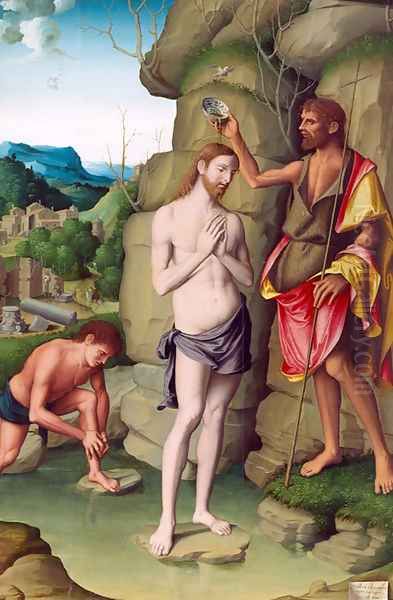
Giovanni Bellini (c. 1430–1516): The leading painter of the Venetian school for much of his career, Bellini's influence was widespread. His mastery of color, light, and atmospheric effects, as well as the profound humanity and devotional intensity of his religious paintings, set a new standard. Palmezzano's work, particularly in its softer modeling and landscape backgrounds, sometimes shows an awareness of Bellini's innovations. The iconography of certain themes, like "Christ Carrying the Cross," may also reflect Bellini's popular compositions. It's plausible Palmezzano encountered Bellini's work through travel to Venice or through paintings and prints that circulated in the Romagna.
The Ferrarese School: Artists like Cosmè Tura (c. 1430–1495), Francesco del Cossa (c. 1436–c. 1478), and Ercole de' Roberti (c. 1451–1496) created a distinctive style in nearby Ferrara, characterized by expressive, often wiry figures, intricate details, and a sometimes unsettling intensity. While Palmezzano's art is generally more serene, the proximity of Ferrara meant that these artistic currents were part of the regional visual culture.
Andrea Mantegna (c. 1431–1506): A towering figure of the North Italian Renaissance, Mantegna, active in Padua and Mantua, was renowned for his mastery of perspective, his sculptural treatment of figures, and his deep engagement with classical antiquity. Some of Palmezzano's works have, at times, been misattributed to Mantegna or his circle, suggesting a perceived similarity in their clarity of line and form, though Mantegna's style is generally more austere and monumental.
Perugino (c. 1446/1452–1523): The leading painter of the Umbrian school, Perugino was immensely popular for his sweet, graceful figures and serene, harmonious compositions. His style was widely influential, and Palmezzano may have absorbed elements of his approach to creating calm, devotional images.
Francesco Francia (c. 1447–1517): A Bolognese painter and goldsmith, Francia's style was similar in some respects to Perugino's, characterized by gentle piety and refined execution. Bologna's proximity to Forlì makes it likely that Palmezzano was familiar with Francia's work.
Luca Signorelli (c. 1445/1450–1523): Known for his powerful, muscular figures and dramatic compositions, particularly his frescoes in Orvieto Cathedral, Signorelli represented a more dynamic and anatomically focused approach than Palmezzano, but was an important contemporary working in Central Italy.
Local Contemporaries: Palmezzano would have interacted with other artists active in Forlì and the Romagna, such as Girolamo Marchesi da Cotignola and the aforementioned Girolamo Marini. These local networks of patronage and artistic exchange shaped the specific character of art in the region. The Zagnetti family was also noted in some contexts as being involved with art, possibly as patrons or minor artists.
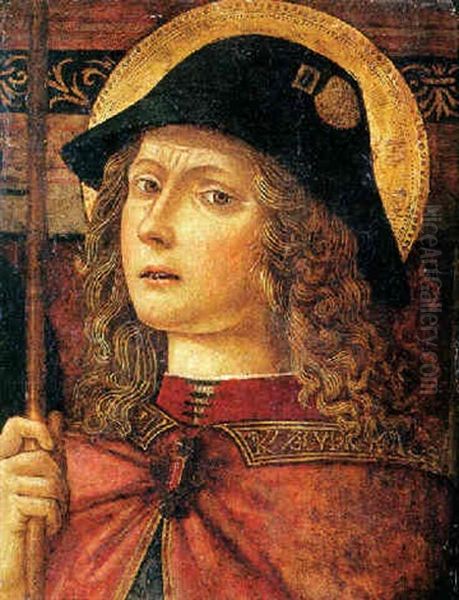
Palmezzano's works were widely distributed in Forlì and its environs, including towns like Faenza and Ravenna. He ran a productive workshop that catered to the demands of local churches, confraternities, and private individuals. His consistent style and reliable output made him a sought-after artist in his region. The presence of his works in Venice also suggests that his reputation extended beyond his immediate locality.
Technical Interests and the Spirit of the Renaissance
The Renaissance was a period of intense intellectual curiosity and technological innovation, and artists were often at the forefront of these developments. The provided information notes Palmezzano's interest in technology, particularly in mechanics and art tools. While specific inventions or treatises by Palmezzano are not widely documented in the manner of Leonardo da Vinci, this interest aligns with the broader spirit of the age.
Artists of the Renaissance were often experimenters, not just with pigments and media, but also with tools and techniques for achieving greater naturalism and illusionism. The development and refinement of perspective systems, the study of anatomy, and the exploration of light and shadow all required a quasi-scientific approach. Palmezzano's solid grounding in perspective, inherited from Melozzo, demonstrates his engagement with these technical aspects of art. His meticulous rendering of detail also suggests a patient and methodical approach to his craft, likely involving careful preparatory drawings and a well-organized workshop practice.
The era saw advancements in the grinding of pigments, the preparation of panels and canvases, and the formulation of varnishes. While Palmezzano was stylistically conservative, he would have benefited from and participated in these ongoing technical refinements within the painter's craft. His long and productive career suggests a mastery of the materials and methods of his time.
Later Life, Legacy, and Posthumous Reputation
Marco Palmezzano continued to be active as a painter into his old age, dying in Forlì in 1539 at around the age of 80. His long career meant that he outlived many of his contemporaries and witnessed significant shifts in artistic taste. Despite the rise of Mannerism in his later years, Palmezzano largely remained true to the artistic principles he had developed earlier in his career.
His legacy is most strongly felt in Forlì and the Romagna, where many of his works remain in their original locations or in local museums. He was a dominant figure in the artistic life of his region for several decades, and his workshop supplied a steady stream of devotional art. The Palmezzano family also became important in Forlì, indicating a degree of social standing achieved through his successful career.
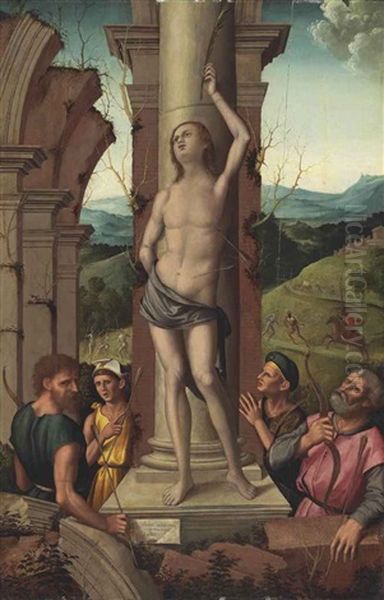
In the broader narrative of Italian Renaissance art, Palmezzano is often considered a provincial master. His conservatism and his geographical distance from the main centers of innovation like Florence, Rome, and Venice have sometimes led to his being overshadowed by more famous names. However, this assessment does not diminish the quality or significance of his work within its own context. He was a highly skilled and respected painter who met the needs of his patrons with diligence and artistry.
The misattribution of some of his works to more celebrated artists like Melozzo da Forlì or Andrea Mantegna is, in a way, a testament to the quality of his painting. It suggests that his technical skill and compositional abilities were, at times, comparable to those of more renowned masters, even if his overall artistic vision was less innovative.
In more recent times, there has been a greater appreciation for regional schools and masters of the Renaissance. Exhibitions and scholarly research have helped to bring artists like Palmezzano into sharper focus, allowing for a more nuanced understanding of their contributions. For instance, exhibitions in Forlì and even as far as Romania have helped to re-evaluate his work and present it to a wider audience. Educational programs and cultural events in Forlì continue to celebrate his artistic heritage, ensuring that his contributions are not forgotten. The San Domenico Museum in Forlì, for example, plays a crucial role in preserving and showcasing his art.
Conclusion: A Steadfast Provincial Master
Marco Palmezzano was a painter of considerable talent and unwavering dedication. Rooted in the artistic traditions of the late Quattrocento and profoundly shaped by his master, Melozzo da Forlì, he forged a long and productive career, becoming the preeminent painter of Forlì and the Romagna for much of his life. While his style remained largely conservative in an era of rapid artistic change, his works are characterized by their meticulous craftsmanship, clear compositions, and sincere devotional spirit.
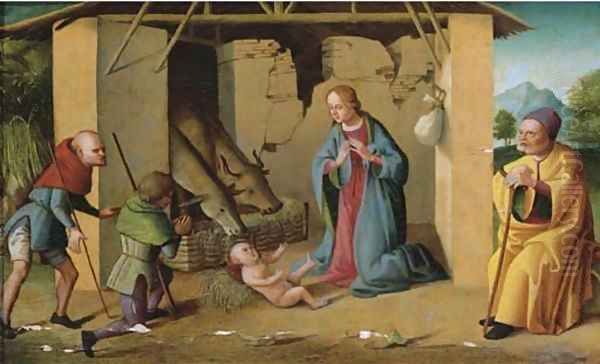
His paintings, predominantly religious in theme, served the spiritual needs of his community and adorned its churches and private homes. He absorbed influences from various artistic currents, including Venetian and Ferrarese art, but integrated them into his own distinct and consistent idiom. While not an innovator on the scale of Leonardo, Michelangelo, or Titian, Palmezzano represents the vital role of regional masters in the rich tapestry of Italian Renaissance art. His legacy endures in the numerous works that survive, offering a window into the artistic and religious life of his time and place. As a diligent craftsman, a respected teacher (as suggested by his workshop's output), and a devout artist, Marco Palmezzano holds an honorable place in the annals of art history.